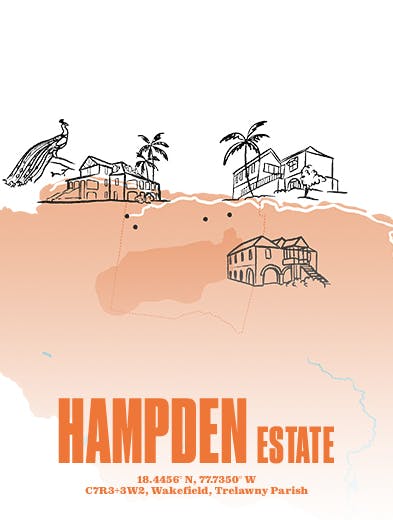Discover the Hampden Estate Distillery


Discover the Hampden Estate Distillery
Rum
Welcome to Trelawny, a region in the north of Jamaica bordered by Cockpit Country’s spectacular mountainous landscapes. Its sharp peaks and deep chasms, sculpted by the erosion of the limestone bedrock, are covered with dense and tangled forests. This mountain range is home to Jamaica’s largest rainforest and its diverse wildlife, including many endemic species of birds and colourful butterflies. Located near the village of Wakefield, in a rural environment surrounded by verdant hills, Hampden Estate produces high ester rums according to methods which have not changed in three centuries. The path to the estate is riddled with potholes, and winds between bamboo thickets and tall sugarcanes. On the path to the distillery, one is immediately struck by intense fragrances of rum, a prelude of sorts to an unforgettable visit.
◊ Past the lane, flanked with its legendary rows of towering palm trees, the gardens of the Great House are lush with the foliage of yuccas, tropical almonds, bougainvillea, red gingers, and spectacular banyans. The screams of peacocks have been known to startle many a visitor.
◊ Beneath the antique timberwork of the Boiling House, lean out over the huge wooden open-air fermentation vats. Looking from one vat to the next, observe the various stages of wash fermentation: frothy and bubbly at first, and covered by a thick layer after a few weeks. If you can tolerate the acidity, dip your finger in and have a taste! Peek under the wooden lids of the fruit vats at the mixture of jackfruit and other macerated tropical fruits, which will feed the fermentation vats. Afterwards, walk across the footbridge overlooking the muck pit, and smell the powerful scents of butyric acid and sulphur… if you have the stomach for it, of course.
◊ In the heat of the stillhouse, breathe in the aromas of pastry and baked apples given off by the four double retort pot stills. Then, venture onto the platform housing the old Vendome stil — still active, seemingly impervious to the weather under its modest corrugated iron roof. The views out onto the surrounding valley are breathtaking.
◊ The estate’s bar welcomes visitors with a Rum Fire punch —high ester rum with local soursop and sorrel. Do not miss the annual Great House release, an exclusive blend only on offer at the distillery.
◊ In the surrounding villages, try the local street food: curried goat or crab with chillies, conches, or jerk—Jamaica’s renowned national dish—with chicken, pork, or goat. You can also find specialities such as roast yams with saltfish, Jamaican festival (fried dumplings), or ackee and saltfish, which is often served for breakfast.
◊ In the evenings, delve into the nightlife of Trelawny’s villages and dance to the rhythms of reggae, dancehall, and afrobeat inside the colourfully-fronted bars.
◊ The more adventurous visitor can hire a guide and explore Cockpit Country’s rainforest, which in the 17th and 18th centuries was home to the Maroon resistance. Its steep terrain and natural mazes made it an ideal refuge for escaped slaves, who waged an intense guerilla war against British colonial oppression. Today, this nature reserve houses 26 species of bird, some of which feature on the labels of single cask bottlings in Hampden Estate’s Trelawny Endemic Birds Series, launched in 2020.
◊ Hyde Hall, Vale Royal, Cambridge… the ruins of some of the Great Houses of the region’s plantations still remain, relics of Jamaican sugarcane production in the 18th century.
Hampden Estate
Hampden Estate





